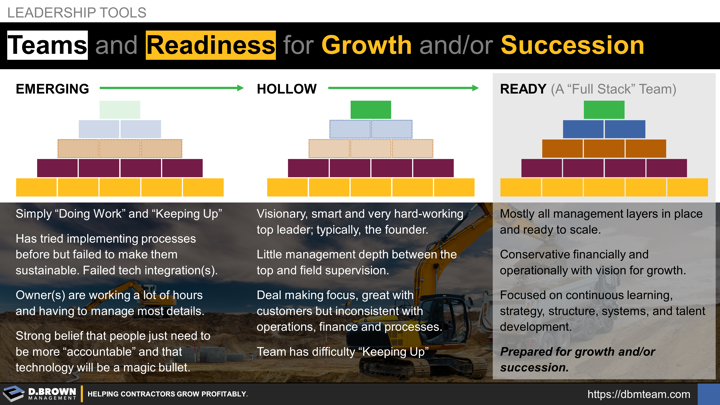A robust organizational structure is stacked with the right mix of talent across the five foundational levels of work for all functional areas of the business required for their current stage of growth and growth trajectory.
All management teams and systems move through these general phases of development at each stage of growth:
- Emerging: Little leadership or management depth, often does not know what they don’t know. Top leader and management team all need to develop comfortable capabilities, capacity, and systems for their current stage of growth.
- Hollow: Top leader is comfortable in capabilities and capacity at the current stage of growth with strong desire and aptitude for the next stage of growth. There are gaps in desires, aptitudes, capabilities, or capacity in one or more roles below the leader, including unfilled roles. There are also likely gaps in the systems required for the next stage.
- Ready: This is “Full-Stack” team. Top leader and management team are all comfortably executing at the current stage of growth with strong desire and aptitude for the next stage of growth. Systems are at least comfortable at current stage of growth with some being able to make it to the next stage of growth with only minor improvements.
SELF-EVALUATION
The list below is not comprehensive or a perfect measure, just some guidelines to consider when evaluating what phase you and your team may be in. To what degree do you and your team think the following descriptions apply to you at this time?
Emerging Management Team
- Simply “Doing Work” and “Keeping Up”
- Has tried implementing processes before but failed to make them sustainable.
- Failed tech integration(s).
- Owner(s) are working a lot of hours and having to manage most details.
- Strong belief that people just need to be more “accountable” and that technology will be a magic bullet.
Hollow Management Team
- Visionary, smart and very hard-working top leader, typically the founder.
- Little management depth between the top and field supervision.
- Deal making focus, great with customers but inconsistent with operations, finance and processes.
- Team has difficulty “Keeping Up”
Ready to Scale ("Full Stack") Management Team
- Mostly all management layers in place and ready to scale.
- Conservative financially and operationally with vision for growth.
- Focused on continuous learning, strategy, structure, systems, and talent development.
- Prepared for growth and/or succession.
Remember that none of these phases is bad and each is normal as part of growth and succession. Winning a couple major projects can be a great win while also taking you from "Ready" back to Hollow or Emerging. Same with the loss of one team member through retirement, maternity leave, or something else. One great recruit to the team can move you from "Hollow" to Ready just as quickly.
Developing yourself, your team, and your systems through each of these phases is both the challenge of growth and the joy of leadership.
Learn More:
Evaluation: Stage of Growth + State of Management Team & Systems
Succession Readiness at All Levels
Succession Planning at All Levels
FIVE FOUNDATIONAL LEVELS OF WORK
Learn More: Stratified Systems Theory (SST) and Timespan 101
- Do Work
- Supervision of Work
- Creating & Managing Systems Within a Functional Area
- Integrating Workflow Across Functional Areas
- Vision, Mission, Culture, Strategy & Long-Term Planning
Keep in mind that all of these must exist to some degree for a contractor at any stage of growth. What changes with growth is the specialization of the people, job roles, and the layers of the organizational structure.
As an example, for a contractor at stage 1 of growth, the owner is likely doing all levels of work from 2-5 and that is perfectly OK at that stage of growth. They are "Ready" to scale. As they navigate to stage 2 of growth, they will have to add in a layer to supervise the work (2). They must do this while extending their definition of "Long-Term Planning" out to 1 or 2 years.
OWNERSHIP TRANSITIONS
How strong the team and organizational structure are will be a major factor in the valuation or in the ability to successfully grow to the next stage.
An experienced and unbiased 3rd party can be invaluable for helping evaluate and develop your team in alignment with your vision for the business. Contact us to schedule time to talk.

